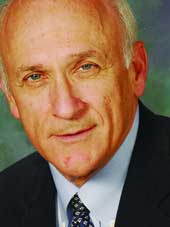Hannon | Dressed for economic success

A conversation with Robert Hannon, Anne Arundel Economic Development Corp. president.
Robert Hannon lives amid the breezes of Chesapeake Bay, in a Maryland county best known as the home of the U.S. Naval Academy. People use the name of the county's most prominent city, Annapolis, as if it and the academy were the same thing.To Hannon, though, that's not enough. As president of the Anne Arundel Economic Development Corp., he is responsible for cultivating a business climate and a quality of life in the county that will attract business and residents.Hannon has held the position since January, and he has years of experience doing similar work for the state of Maryland and Baltimore.The economic development corporation offers a variety of resources for businesses, including the Chesapeake Innovation Center and small-business funding programs. CIC, an incubator, has a close relationship with the National Security Agency.Hannon recently spoke with Washington Technology Associate Editor Michael Hardy about economic development. Anne Arundel County is a rapidly growing county. We've got more than 500,000 people in the county today. We sit in the middle of two major metropolitan areas, Baltimore and Washington. The corridor location of the county lends itself to discussions of how transportation is one of the assets we look to. Transportation certainly looms as one of the major [factors].We have Fort Meade. More than just an Army base, Fort Meade is a major research and development center. Fort Meade is the host base of the National Security Agency, so there is a base of talent, be that civilian agency talent or uniformed military, based at Fort Meade.So transportation, the concentration of a high amount of talent, the quality of living that exists here, really begin to establish the major parameters around which an economy of a single jurisdiction is based. I look at the resident workforce, as talented as it may be, as a regional workforce. A good half of them go to work here every day, but a good half of them commute away from here. At the same time, you have inbound commuting that comes to fill our technology jobs.The greatest concentration of jobs that you have within the jurisdiction creates that array of opportunities for your residents to stay at home. Youare seeing growing trends to work at home from secure computing systems. I've seen greater regionalization and the growing affluence that this area has enjoyed. Because they are affluent, people have more choices, and often that choice is to live at some distance from where they work. In the early '80s, we saw much greater concentrations of workers working closer in than you see today. The increased division of labor that creates niche companies and niche industries across the board is evident. We certainly, especially in this area, are driving such a high degree of academic education as the foundation for workforce positions.In times past ? you can look back over a longer historical period ? trade and commerce [were] always closely tied to interstate transportation. Now with the increased globalization of all our business, airports become the key phenomenon. I see forces at work that are driving businesses closer to the airports. There is sort of an edge city taking place around Baltimore/Washington International Thurgood Marshall Airport. In the larger context, competition is part of our business world. Part of the job of an economic development agency is to showcase the best attributes, to use salesmanship [to attract businesses]. Certainly we do compete ? not in a cutthroat fashion, but we have very strong assets that are part of the reason business should want to be here. Economic development serves a primary public function. Our job is to make sure there is an ample supply of quality jobs within a community. You build a sound society by making certain there are family-supporting jobs within the community. The security and satisfaction that the jobs provide you build solid families, the families build solid neighborhoods, and the neighborhoods build solid communities.

Q: What do you look for in assessing an area's strengths and what it needs to strengthen its economy?
Hannon:
Q: How do you gauge the county's workforce?
Hannon:
Q: What has changed in the years you've been working in economic development?
Hannon:
Q: What will change in the near future?
Hannon:
Q: How much competition is there between regions?
Hannon:
Q: What is your philosophy about economic development?
Hannon:

I look at the resident workforce, as talented as it may be, as a regional workforce. - Robert Hannon
Q: What do you look for in assessing an area's strengths and what it needs to strengthen its economy?
Hannon:
Q: How do you gauge the county's workforce?
Hannon:
Q: What has changed in the years you've been working in economic development?
Hannon:
Q: What will change in the near future?
Hannon:
Q: How much competition is there between regions?
Hannon:
Q: What is your philosophy about economic development?
Hannon:
NEXT STORY: Small companies, new ideas

